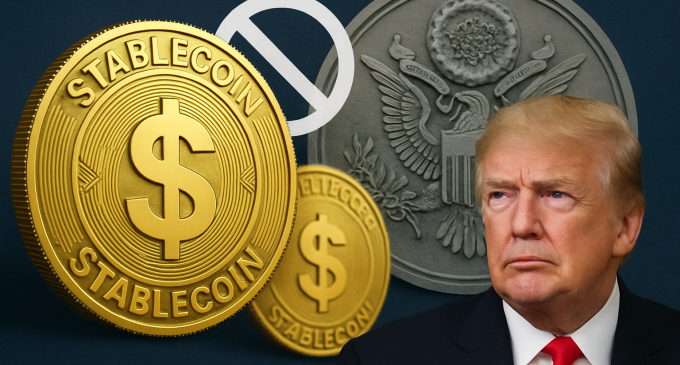
Introduction
The passage of the GENIUS Act in July 2025 has ignited a significant shift in how the United States handles digital financial instruments, particularly stablecoins. These cryptocurrencies, designed to mirror the value of fiat currencies like the U.S. dollar, now find themselves at the center of a broader economic and political conflict. While President Donald Trump and his allies in Congress have championed the cause of stablecoin innovation, the Federal Reserve has raised concerns over monetary sovereignty, systemic risk, and long-term economic implications. This evolving dynamic has set the stage for a fresh confrontation between the executive branch and the central bank, potentially reshaping the future of American financial infrastructure.
The GENIUS Act And The Rise Of Regulated Stablecoins
The Generational Economic National Infrastructure for Ubiquitous Stablecoins Act, or GENIUS Act, is the most consequential piece of crypto legislation ever passed in the United States. The Act mandates that issuers of U.S.-dollar-backed stablecoins be fully licensed, hold 100 percent reserve backing in cash or cash equivalents, and conduct monthly public audits. Unlike previous legislative efforts that fell short, this Act provides legal clarity while firmly defining the boundaries of issuance and compliance. It explicitly prevents stablecoins from being treated as either securities or bank liabilities.
The bipartisan support for the GENIUS Act came amid a broader push to reclaim technological and monetary leadership from countries like China, which has aggressively deployed its digital yuan across both domestic and international markets. The legislation has opened the door for companies such as Circle, Ripple, and PayPal to accelerate their digital dollar products, offering seamless and fast payments through blockchain rails while operating within a regulated environment. This move is seen by supporters as a necessary innovation to maintain dollar supremacy in the digital era.
The Federal Reserve Pushback: Control Over Payments Infrastructure
Despite the GENIUS Act’s overwhelming support in Congress and celebration by the crypto sector, the Federal Reserve has not been enthusiastic. Fed officials, including Chair Jerome Powell and Vice Chair Michael Barr, have consistently raised red flags regarding the potential risks posed by privately issued stablecoins. These concerns range from their use in illicit finance and insufficient consumer protections to the potential erosion of the central bank’s influence over the monetary system.
At the heart of the Fed’s resistance is the control over payment infrastructure. Stablecoins, particularly those integrated into popular apps and financial platforms, could eventually circumvent the traditional banking system altogether. This would diminish the Fed’s control over money supply and its ability to implement monetary policy effectively. The central bank’s longstanding dominance in managing interest rates, liquidity, and inflation could be challenged by a parallel system of programmable money beyond its oversight.
The Fed has signaled its intent to introduce its own digital currency—commonly referred to as a central bank digital currency (CBDC)—but has met opposition from the Trump-aligned GOP, who see it as a vehicle for government overreach and potential surveillance.
Trump’s Strategic Embrace Of Crypto
The Trump administration’s full-throated embrace of cryptocurrencies marks a stark departure from the regulatory ambiguity of prior administrations. In 2025, Trump has gone beyond merely tolerating crypto assets. His administration sees them as a strategic asset class with the power to modernize payments, reduce reliance on traditional banks, and increase financial access. Trump’s allies in Congress have passed not just the GENIUS Act, but also the CLARITY Act, which delineates the roles of regulatory agencies like the SEC and CFTC, and the Anti-CBDC Surveillance State Act, which prohibits the Fed from issuing a central bank digital currency without explicit Congressional approval.
Trump’s political base includes a vocal libertarian segment that supports decentralized finance and distrusts traditional institutions. The administration’s messaging portrays the stablecoin expansion as a means of financial liberation and American innovation. Under this framework, private companies are encouraged to innovate while complying with transparent, rules-based frameworks. Trump’s Commerce Department has even signaled that stablecoins could soon be integrated into federal procurement systems, lending further legitimacy to the sector.
Private Innovation Vs Central Authority
This confrontation underscores a broader ideological battle between decentralized innovation and centralized control. On one hand, stablecoins offer clear benefits: faster transaction speeds, lower costs, greater financial access, and the potential for programmable financial services. On the other hand, central banks worldwide, including the Fed, are reluctant to surrender their exclusive control over the issuance and management of money.
The Federal Reserve is particularly wary of a scenario in which stablecoins, issued by corporations and backed by assets like Treasury bills, begin to replace traditional bank deposits. This could destabilize traditional financial institutions, encourage capital flight during crises, and increase volatility in money markets. Moreover, the absence of a universally accepted digital dollar issued by the Fed would fragment the monetary landscape, complicating policy execution and financial stability.
Fedwire Access: The Next Battle
One of the most contentious issues yet to be resolved is whether stablecoin issuers should be granted access to Fedwire, the central bank’s real-time gross settlement system. Access to Fedwire would allow stablecoin providers to settle large transactions instantly, increasing efficiency and reducing reliance on intermediary banks. However, granting such access would also elevate these companies to a status akin to banks or clearinghouses, potentially undermining the traditional separation between private financial firms and the federal monetary apparatus.
Some lawmakers have proposed limited Fedwire access for fully compliant and audited stablecoin issuers, but Fed officials have resisted, arguing that such a move could create risks to financial stability and national monetary policy. The final decision on Fedwire access could determine how quickly stablecoins can scale into broader use and whether the U.S. maintains a lead in the global digital payments race.
Global Implications Of U.S. Stablecoin Strategy
The international implications of this conflict are profound. Other jurisdictions such as the European Union, the United Kingdom, and Singapore are also moving forward with digital asset regulations. However, most of these frameworks involve heavy central bank oversight and tight controls on issuance. If the United States, under Trump, adopts a more open and private-sector-driven approach, it could set a global precedent for how decentralized finance integrates into national economies.
This would also affect global dollar usage. A well-regulated and accessible stablecoin, pegged to the dollar and widely used across platforms, could serve as a digital dollar substitute in countries with weaker currencies or less developed banking systems. Such a development would reinforce the dollar’s role as the world’s reserve currency but would do so through private rails rather than sovereign control, thereby creating friction with global central banks.
The Road Ahead: Uncharted Monetary Terrain
As the Federal Reserve and the Trump administration continue their standoff, stablecoins are likely to emerge as a key battlefront in the future of monetary control. The implications go far beyond just cryptocurrency. They touch on fundamental questions about who controls money, how it is distributed, and what role governments and private companies should play in its creation and use.
The GENIUS Act may have laid the foundation, but the confrontation over Fedwire access, monetary policy, and international implications is just beginning. Whether stablecoins are ultimately seen as a tool of liberation or a threat to central authority will depend on how these next conflicts are navigated. In either case, the financial system of the future is being built today—and stablecoins are no longer just a technological novelty. They are now a political and economic force with the power to reshape global finance.
Conclusion
The emergence of stablecoins as a legitimate financial instrument through the GENIUS Act has catapulted the United States into a new phase of monetary evolution, marked by both innovation and institutional tension. While the Trump administration envisions a future where private companies drive digital dollar adoption under clear regulatory frameworks, the Federal Reserve views this transformation with caution, fearing the erosion of its monetary sovereignty and systemic oversight. This ideological and structural conflict is more than a policy disagreement—it is a foundational battle over who will control the future of money in America.







There are no comments at the moment, do you want to add one?
Write a comment